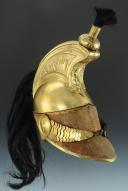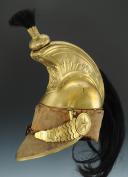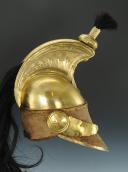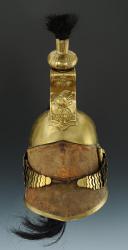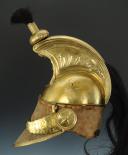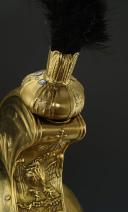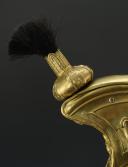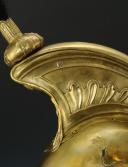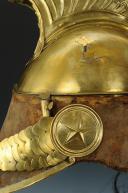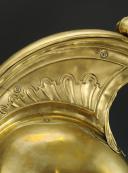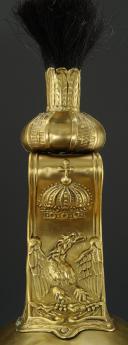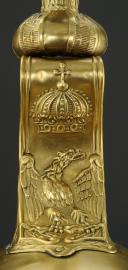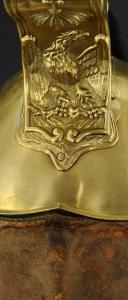
Imperial Guard Dragons Helmet, known as "Empress's Dragoons", Model 1806, First Empire.
Sold out
HELMET OF THE DRAGONS TROOPS OF THE IMPERIAL GUARD, KNOWN AS THE "EMPRESS'S DRAGONS", 1806 MODEL, FIRST EMPIRE.
All the metal parts of this model are made of stamped brass.
The single-piece stamped bomb has a depth of about 10 cm. It is tilted backward to give it a shape known as "à la Minerve". A protruding gutter, 5 mm high, is soldered at the base; at the front, it forms an upward-pointing tip. This gutter is designed to prevent water from the wells from flowing onto the turban.
The strong leather turban is stapled to the bomb with five steel threads, with a height of 9 cm at the front, scalloped on each side at ear level to 8 cm. At the back, a leather strap is sewn, adjustable with a brass buckle, to adapt the headdress to the rider's head. The turban is covered with dyed skin to imitate a panther.
The leather visor, restored, forms a pointed shape and measures 9 cm in width. As the helmet from the former Thélot collection has a sabre cut on it, the visor was repaired at the time and is round in shape. This visor is sewn at the base of the turban. The outer edge is encircled by a replaced brass strip, folded over and crimped (it can also be riveted in four points). The inside is lined with dark brown sheepskin. Some helmets are equipped with a detachable visor that is attached to the turban with two small steel hooks.
Chinstraps consist of two parts each: a chin strap and a rosette. The rosette is round, measuring 6.5 cm in diameter, stamped with a five-pointed star. Fixed to the turban by two brass tabs soldered at the back. The chin strap is made of dark brown sheepskin. It is covered with 15 cut scales, the widest of which measures 5.8 cm, and the narrowest measures 1.7 cm. The scales are stapled to the sheepskin. The total length is 16.1 cm. Lace has been replaced at a later date.
Plume holder. It is attached in front of the left rosette, on the turban. The round tube (1.3 cm in diameter, 5.2 cm in height) tapers towards the bottom, with a screw at the top to secure the plume. The tube is notched at the top and bottom to be attached to the turban with a brass wire.
Crest. It consists of two fins, a mask, and a covering plate. Each fin is shaped like a case, with a maximum height of 12.2 cm. The center is stamped with a decreasing series of 9 gadroons. The bottom is folded over the bomb and forms four scallops. Each fin is attached to the bomb with four rivets. The mask measures 5.8 cm in width, depicting an eagle facing left holding a thunderbolt with lightning in its talons. Above the eagle is stamped an imperial crown. At the top, the mask is turned and notched for the plume holder. The bottom widens and forms a rounded point at the front, decorated with two palm leaves and riveted. It is worth noting that the helmets of the Dragons of the Kingdom of Italy are similar, except the eagle on the mask is facing to the right and is topped with the iron crown. The covering plate covers the top of the crest, measuring approximately 35 cm in length. It is notched at the front to accommodate the plume holder and is attached to the bomb at the back with a brass wire. The crest can be placed more or less behind the bomb, with the bottom of the mask positioned 2.2 cm from the bottom of the bomb.
Plume holder. It consists of three parts: the lens (or olive), the socket, and the brush (also known as the plume or aigrette). The lens is made of brass with 10 slats, each decorated alternately with a horizontally striped background or a pattern of beads and diamonds. It measures 6.7 cm in diameter and 3.5 cm in height, with a period repair with two rivets. The socket has eight slats decorated with palm leaves, with the top notched in scallops. The total height is 3.3 cm. The plume is made of black horsehair approximately 6 cm high, partly re-garnished. The plume holder is attached to the bomb by a long steel rod welded to a screw that screws into the base of the socket.
Black horsehair mane, mounted on a leather sole. It is placed inside the crest and hangs backwards in a flowing tail, with a length of 30 cm. In 1806, the mane was visible at the level of the plume holder and cascaded down on each side, evolving to increasingly extend from the rear of the crest.
Missing interior liner.
Total height of the helmet: approximately 42 cm.
Very good state of preservation, with an accident and repair on one side of the bomb.
France.
First Empire.
HISTORICAL BACKGROUND:
Decree of May 10, 1804: "The Guard is informed that the Senate has proclaimed Napoléon Bonaparte Emperor of the French today and has fixed the hereditary power in his family. Long live the Emperor! Unbounded devotion and unfailing loyalty to Napoléon the 1st, Emperor of the French. Today, the Guard takes on the title of the Imperial Guard."
Of all the cavalry regiments of the Imperial Guard, only one was equipped with a helmet, the Dragons. This magnificent headdress, a symbol of prestige for the regiment, is the subject of our study.
The Origin of the Emperor's Dragons
It was in the 16th century that Marshal de Brissac gave the name "dragons" to his mounted arquebusiers, in memory of the mythical creature that chivalry had taken as a symbol of courage. The true ancestors of the Imperial Guard cavalry are, in fact, the "Sergents à masse" of the Military House of the Kings of France. More directly, the Guard of the Consuls was the first troop attached to Bonaparte's person (under the Revolution); it became the Imperial Guard on May 10, 1804. At the head of his Guard, the Emperor placed an officer close to him, Marshal Bessières; he would command with the rank of Colonel General from July 20, 1804.
Dragons Join the Guard
It wasn't until 1806, one of the finest years of the Empire, that a regiment of Dragons belonged to the Imperial Guard. The 1805 campaign had just demonstrated the value of the line Dragons regiments; in reward, Napoléon proclaimed on April 15, 1806: "The Imperial Guard will be composed of (...) 1 regiment of Dragons with 4 squadrons." This new corps included: 1 Staff, 4 squadrons with 2 companies each, 1 Vélites squadron. The Guard regiment was formed by selecting 12 Dragons, with at least ten years of service, from each of the 30 line regiments. Composed of elite soldiers, the officers were chosen by Napoléon himself, after verifying their service records. To command the regiment, the Emperor appointed a highly distinguished officer: Colonel Arrighi de Casanova, who now held the rank of Major-Colonel. Arrighi de Casanova, Colonel of the 1st Dragons regiment, was a cousin by marriage to the Emperor.
The Empress's Dragons
Once the squadrons were organized, His Majesty placed them under the protection of Empress Joséphine, giving them the nickname "Empress's Dragons". Although the said nickname was of the period, it was not officially or regularly worn, but symbolically distinguished them from the Queen of Prussia's Dragons. In 1807, the regiment consisted of 560 men; the Napoleonic Wars would soon heavily deplete its ranks. On June 6, 1809, Colonel Arrighi de Casanova was replaced by Count de Saint-Sulpice, then a Divisional General. On January 21, 1813, a new Colonel was appointed: Divisional General d'Ornano, who would command the regiment until 1815, including during the First Restoration when the regiment became the Royal Corps of the Dragons of France.
War Service
The regiment of the Imperial Guard Dragons participated in all the campaigns of the Empire: Prussia (1807), Poland (1807), Spain (1808), Austria (1809), Russia (1812) where only half the unit returned! France (1814). Present in battles such as: Friedland (1807), Eylau (1808), Somosierra (1808), Wagram (1809), Maloyaroslavets (1812) where they prevented the Cossacks from capturing the Emperor, Lutzen (1813), Kulm (1813), Wachau (1813)...
When the Guard's Dragons Were Branded "Muscadins"!
In 1806, the choice of the uniform for the regiment of the Imperial Guard Dragons was left to the initiative of Arrighi de Casanova. Wanting to command a modern troop, the Major-Colonel first removed all the "accessories" he deemed unnecessary: tails, breeches, stockings... The finalized uniform was close to that of the Grenadiers à Cheval of the Guard, but with a green coat and a brass helmet adopted. Marshal Bessières, not very receptive to this new spirit, called them "Muscadins" (a name given during the Directory to elegant royalists who made prominent use of perfume and ribbons). One morning, the regiment's uniform, worn by two non-commissioned officers, was presented to the Emperor at the Palace of Saint-Cloud and was accepted.
The 1806 Helmet: Existing Pieces
The study of the 1806 model helmet is hindered by the absence of archives, and only a document of von Breitenbach provides the following description: "Casque in yellow metal, panther skin, black mane and plume". Therefore, we must base our study on period iconography and empirically examine carefully preserved authentic helmets. Thus far, only eight authentic 1806 troop helmets are known to us:
• The first is part of the former Raoul and Jean Brunon collection, now in the collection of the Army Museum, housed at the Château de l'Empéri in Salon-de-Provence.
• The second one comes from the former Edouard Detaille collection and is currently stored in the reserves of the Army Museum in Paris.
• The third, having belonged to the Grand Duke of Hesse's collection and later from Mr. Hollitzer in Vienna, was sold at the Drouot Hotel (Paris) in 1932, acquired by a French collector.
• The fourth, also from the Grand Duke of Hesse's collection and later Mr. Hollitzer in Vienna, was sold at the Drouot Hotel (Paris) in 1932, acquired by a French collector whose collection is now on display at the Château du Fort de Joux in Pontarlier.
• The fifth helmet, from the collections of the Prince de la Moskova, is likely currently in a private collection, featuring a bullet hole.
• The sixth belonged to Mr. Thélot (a French collector), and it is now part of a French collection.
• The seventh is in a private collection.
• The helmet presented here is the eighth known and documented troop helmet of this kind.
All the metal parts of this model are made of stamped brass.
The single-piece stamped bomb has a depth of about 10 cm. It is tilted backward to give it a shape known as "à la Minerve". A protruding gutter, 5 mm high, is soldered at the base; at the front, it forms an upward-pointing tip. This gutter is designed to prevent water from the wells from flowing onto the turban.
The strong leather turban is stapled to the bomb with five steel threads, with a height of 9 cm at the front, scalloped on each side at ear level to 8 cm. At the back, a leather strap is sewn, adjustable with a brass buckle, to adapt the headdress to the rider's head. The turban is covered with dyed skin to imitate a panther.
The leather visor, restored, forms a pointed shape and measures 9 cm in width. As the helmet from the former Thélot collection has a sabre cut on it, the visor was repaired at the time and is round in shape. This visor is sewn at the base of the turban. The outer edge is encircled by a replaced brass strip, folded over and crimped (it can also be riveted in four points). The inside is lined with dark brown sheepskin. Some helmets are equipped with a detachable visor that is attached to the turban with two small steel hooks.
Chinstraps consist of two parts each: a chin strap and a rosette. The rosette is round, measuring 6.5 cm in diameter, stamped with a five-pointed star. Fixed to the turban by two brass tabs soldered at the back. The chin strap is made of dark brown sheepskin. It is covered with 15 cut scales, the widest of which measures 5.8 cm, and the narrowest measures 1.7 cm. The scales are stapled to the sheepskin. The total length is 16.1 cm. Lace has been replaced at a later date.
Plume holder. It is attached in front of the left rosette, on the turban. The round tube (1.3 cm in diameter, 5.2 cm in height) tapers towards the bottom, with a screw at the top to secure the plume. The tube is notched at the top and bottom to be attached to the turban with a brass wire.
Crest. It consists of two fins, a mask, and a covering plate. Each fin is shaped like a case, with a maximum height of 12.2 cm. The center is stamped with a decreasing series of 9 gadroons. The bottom is folded over the bomb and forms four scallops. Each fin is attached to the bomb with four rivets. The mask measures 5.8 cm in width, depicting an eagle facing left holding a thunderbolt with lightning in its talons. Above the eagle is stamped an imperial crown. At the top, the mask is turned and notched for the plume holder. The bottom widens and forms a rounded point at the front, decorated with two palm leaves and riveted. It is worth noting that the helmets of the Dragons of the Kingdom of Italy are similar, except the eagle on the mask is facing to the right and is topped with the iron crown. The covering plate covers the top of the crest, measuring approximately 35 cm in length. It is notched at the front to accommodate the plume holder and is attached to the bomb at the back with a brass wire. The crest can be placed more or less behind the bomb, with the bottom of the mask positioned 2.2 cm from the bottom of the bomb.
Plume holder. It consists of three parts: the lens (or olive), the socket, and the brush (also known as the plume or aigrette). The lens is made of brass with 10 slats, each decorated alternately with a horizontally striped background or a pattern of beads and diamonds. It measures 6.7 cm in diameter and 3.5 cm in height, with a period repair with two rivets. The socket has eight slats decorated with palm leaves, with the top notched in scallops. The total height is 3.3 cm. The plume is made of black horsehair approximately 6 cm high, partly re-garnished. The plume holder is attached to the bomb by a long steel rod welded to a screw that screws into the base of the socket.
Black horsehair mane, mounted on a leather sole. It is placed inside the crest and hangs backwards in a flowing tail, with a length of 30 cm. In 1806, the mane was visible at the level of the plume holder and cascaded down on each side, evolving to increasingly extend from the rear of the crest.
Missing interior liner.
Total height of the helmet: approximately 42 cm.
Very good state of preservation, with an accident and repair on one side of the bomb.
France.
First Empire.
HISTORICAL BACKGROUND:
Decree of May 10, 1804: "The Guard is informed that the Senate has proclaimed Napoléon Bonaparte Emperor of the French today and has fixed the hereditary power in his family. Long live the Emperor! Unbounded devotion and unfailing loyalty to Napoléon the 1st, Emperor of the French. Today, the Guard takes on the title of the Imperial Guard."
Of all the cavalry regiments of the Imperial Guard, only one was equipped with a helmet, the Dragons. This magnificent headdress, a symbol of prestige for the regiment, is the subject of our study.
The Origin of the Emperor's Dragons
It was in the 16th century that Marshal de Brissac gave the name "dragons" to his mounted arquebusiers, in memory of the mythical creature that chivalry had taken as a symbol of courage. The true ancestors of the Imperial Guard cavalry are, in fact, the "Sergents à masse" of the Military House of the Kings of France. More directly, the Guard of the Consuls was the first troop attached to Bonaparte's person (under the Revolution); it became the Imperial Guard on May 10, 1804. At the head of his Guard, the Emperor placed an officer close to him, Marshal Bessières; he would command with the rank of Colonel General from July 20, 1804.
Dragons Join the Guard
It wasn't until 1806, one of the finest years of the Empire, that a regiment of Dragons belonged to the Imperial Guard. The 1805 campaign had just demonstrated the value of the line Dragons regiments; in reward, Napoléon proclaimed on April 15, 1806: "The Imperial Guard will be composed of (...) 1 regiment of Dragons with 4 squadrons." This new corps included: 1 Staff, 4 squadrons with 2 companies each, 1 Vélites squadron. The Guard regiment was formed by selecting 12 Dragons, with at least ten years of service, from each of the 30 line regiments. Composed of elite soldiers, the officers were chosen by Napoléon himself, after verifying their service records. To command the regiment, the Emperor appointed a highly distinguished officer: Colonel Arrighi de Casanova, who now held the rank of Major-Colonel. Arrighi de Casanova, Colonel of the 1st Dragons regiment, was a cousin by marriage to the Emperor.
The Empress's Dragons
Once the squadrons were organized, His Majesty placed them under the protection of Empress Joséphine, giving them the nickname "Empress's Dragons". Although the said nickname was of the period, it was not officially or regularly worn, but symbolically distinguished them from the Queen of Prussia's Dragons. In 1807, the regiment consisted of 560 men; the Napoleonic Wars would soon heavily deplete its ranks. On June 6, 1809, Colonel Arrighi de Casanova was replaced by Count de Saint-Sulpice, then a Divisional General. On January 21, 1813, a new Colonel was appointed: Divisional General d'Ornano, who would command the regiment until 1815, including during the First Restoration when the regiment became the Royal Corps of the Dragons of France.
War Service
The regiment of the Imperial Guard Dragons participated in all the campaigns of the Empire: Prussia (1807), Poland (1807), Spain (1808), Austria (1809), Russia (1812) where only half the unit returned! France (1814). Present in battles such as: Friedland (1807), Eylau (1808), Somosierra (1808), Wagram (1809), Maloyaroslavets (1812) where they prevented the Cossacks from capturing the Emperor, Lutzen (1813), Kulm (1813), Wachau (1813)...
When the Guard's Dragons Were Branded "Muscadins"!
In 1806, the choice of the uniform for the regiment of the Imperial Guard Dragons was left to the initiative of Arrighi de Casanova. Wanting to command a modern troop, the Major-Colonel first removed all the "accessories" he deemed unnecessary: tails, breeches, stockings... The finalized uniform was close to that of the Grenadiers à Cheval of the Guard, but with a green coat and a brass helmet adopted. Marshal Bessières, not very receptive to this new spirit, called them "Muscadins" (a name given during the Directory to elegant royalists who made prominent use of perfume and ribbons). One morning, the regiment's uniform, worn by two non-commissioned officers, was presented to the Emperor at the Palace of Saint-Cloud and was accepted.
The 1806 Helmet: Existing Pieces
The study of the 1806 model helmet is hindered by the absence of archives, and only a document of von Breitenbach provides the following description: "Casque in yellow metal, panther skin, black mane and plume". Therefore, we must base our study on period iconography and empirically examine carefully preserved authentic helmets. Thus far, only eight authentic 1806 troop helmets are known to us:
• The first is part of the former Raoul and Jean Brunon collection, now in the collection of the Army Museum, housed at the Château de l'Empéri in Salon-de-Provence.
• The second one comes from the former Edouard Detaille collection and is currently stored in the reserves of the Army Museum in Paris.
• The third, having belonged to the Grand Duke of Hesse's collection and later from Mr. Hollitzer in Vienna, was sold at the Drouot Hotel (Paris) in 1932, acquired by a French collector.
• The fourth, also from the Grand Duke of Hesse's collection and later Mr. Hollitzer in Vienna, was sold at the Drouot Hotel (Paris) in 1932, acquired by a French collector whose collection is now on display at the Château du Fort de Joux in Pontarlier.
• The fifth helmet, from the collections of the Prince de la Moskova, is likely currently in a private collection, featuring a bullet hole.
• The sixth belonged to Mr. Thélot (a French collector), and it is now part of a French collection.
• The seventh is in a private collection.
• The helmet presented here is the eighth known and documented troop helmet of this kind.
Reference :
12478
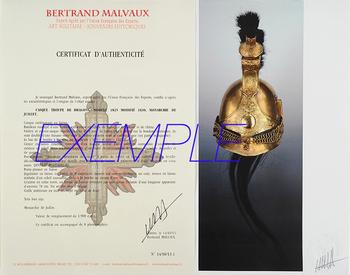
Next update Friday, may 2 at 13:30 PM
FOR ALL PURCHASES, PAYMENT IN MULTIPLE CHECKS POSSIBLE
bertrand.malvaux@wanadoo.fr 06 07 75 74 63
An authenticity certificate of the item including the description published on the site, the period, the sale price, accompanied by one or more color photographs is automatically provided for any item priced over 130 euros. Below this price, each certificate is charged 5 euros.
Only items sold by me are subject to an authenticity certificate, I do not provide any expert reports for items sold by third parties (colleagues or collectors).
